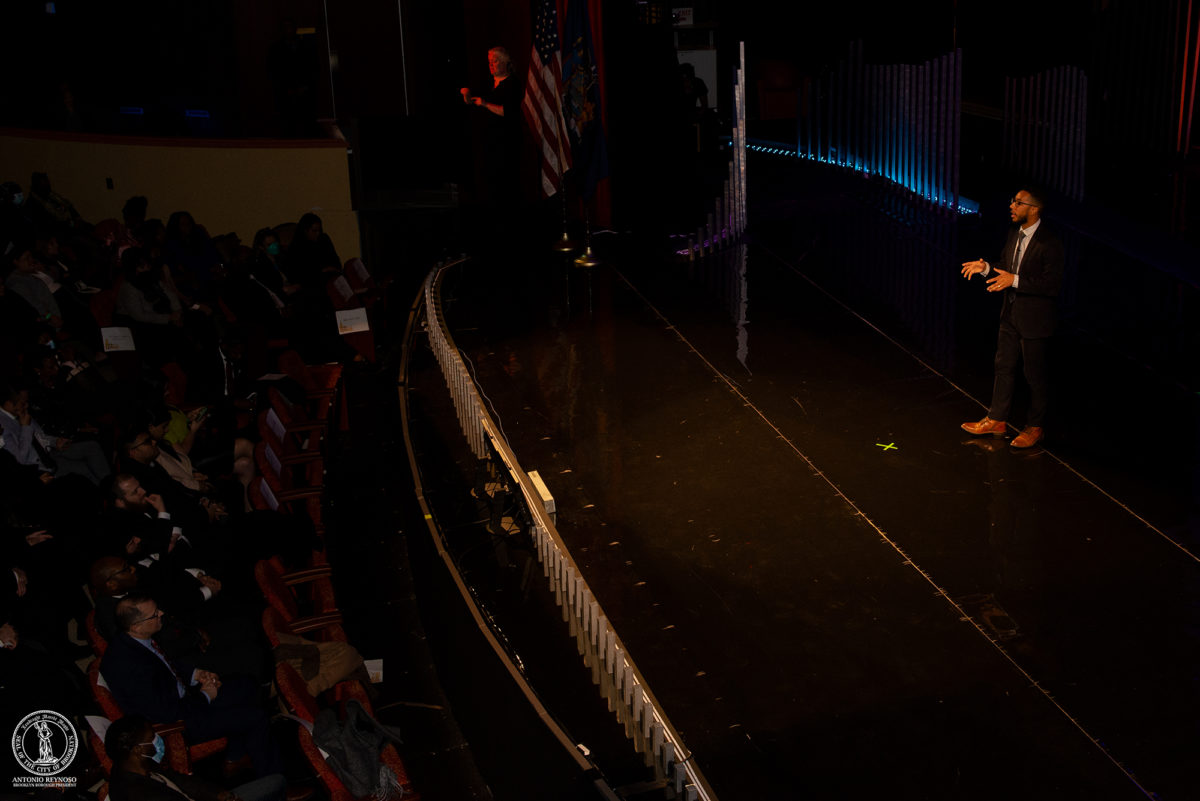Brooklyn State of the Borough returns
By Matthew Fischetti
mfischetti@queensledger.com
The State of the Borough is back in Kings County.
After a decade of not having one, elected officials and members of the public attended Brooklyn Beep Antonio Reynoso’s first State of the Borough last week at the New York College of Technology.
Maternal Health Care
One of the main focuses of Reynoso’s first term as Borough President has centered around improving the maternal health conditions in Brooklyn. A 2021 report from the city found that a third of all New York City pregnancy deaths occur in Kings County.
“One in every three pregnancy-related deaths in New York City are happening here, in our borough.Right here in Brooklyn, Black women are dying at 9.4 times the rate of their White counterparts because of pregnancy-related complications.It’s one of the greatest inequities, greatest injustices that we’re bearing witness to,” Reynoso said in his speech.
In order to tackle the issue, Reynoso has allocated the entirety of his 2023 funding, which totals $45 million, to funding maternal healthcare improvements across the borough’s three public hospitals. Reynoso also instituted a maternal task force back in April made up of eight black women OBGYNs, mental health workers, doulas and other experts to inform policy.
The Borough President’s office has also spent $250,000 on a public health messaging campaign this year to connect at-risk residents with a resource guide influenced by the task force’s recommendations. Most recently, Reynoso was able to help provide 500 free baby boxes that contained baby materials as well as post-partum resources after giving a $100k grant to
Comprehensive Planning
One of the other major accomplishments Reynoso highlighted in his speech was the launching of the borough’s comprehensive planning effort. Reynoso criticized the status quo of New York not having one, unlike many major metro areas.
“Yet, despite being the most populous city in the country, New York City is noticeably lacking a plan like this–and instead of planning, we have a piecemeal zoning approval process that we all know isn’t getting the job done,” Reynoso said.
Reynoso emphasized that his comprehensive planning will center around public health and housing outcomes.
“The key to comprehensive planning is to have a clear objective, and our focus is set squarely on the intersection of housing and public health. Because of decades of racist city planning and a long legacy of segregation, our communities of color are clustered in the areas with the poorest housing conditions, the least access to resources, and the worst health outcomes,” Reynoso said.
In his speech, Reynoso also emphasized that building wouldn’t be limited to nabes that have seen development in recent years – like Downtown Brooklyn, Williamsburg or East New York – but would also focus on areas that have not had rezonings in decades.
“It’s no coincidence that 90 percent of childhood lead poisoning cases involve children of color,or that our neighbors in eastern Brooklyn are dying sooner, with the highest rates of premature mortality in the entire borough,” he added.
Looking forward
Reynoso outlined four major policies for the upcoming year, including: providing permanent houses for nonprofits, increasing Black-owned business in Brownsville, Community Board Reform, and a “solar saving plan”.
In terms of providing permanent homes for nonprofits, Reynoso said the move was so that the organizations could eliminate wasted time on finding facilities or negotiating with landlords, and focus more on providing their services.
“Because listen, the people of Brooklyn can’t keep building a better life for themselves, their families, and their communities when their money is all caught up in just surviving. And that applies just as much to our nonprofits as it does to our low-income tenants,” he said.
Reynoso said in his speech that he would be working with the Central Brooklyn Economic Development Corporation to help spurn new business. Of the first groups selected in the program, a smaller group will be selected to receive free space on underused commercial corridors in Brownsville.
“Black unemployment in New York City stands at 9.7 percent compared to 5.5 percent of their White counterparts. At the neighborhood level, Brownsville alone has an exceptionally high black unemployment rate of 11.2 percent,” Reynoso said in his speech.
Reynoso’s solar plan focuses on providing a “large-scale” central solar plant to help lower-income New Yorkers who cannot take advantage of roof solarization. A 2019 report from the Mayor’s office found that 32 percent of Brooklyn families in 2017 were “utility burdened,” spending more than 6 percent of their income on utilities – prior to recent rate increases.
The last major policy Reynoso said he looks to work on this year is related to community board reform. Reynoso stated that he wants to reform the unclear responsibilities divided between mayoral agencies and the borough president’s office. The new guidance from the Beep’s office would Reynoso also emphasized that his office wants to provide greater diversity, in all aspects of the word.
“I’m not just talking race and ethnicity. I’m talking about interests, education, or ability status. Do you drive a car or take public transportation? Do you own a home or are you a renter? Are you a single parent? Are you a NYCHA resident?Nearly one-quarter of Brooklyn is 18 years old or younger, but most applicants and appointees to community boards last year were ages 45-64. So, we’re also talking about age,” he said.
Reynoso also noted that he is specifically looking to place two members between 16 and 18 years old on each of the borough’s 18 community boards. Applications for the community board are open until February 14.



